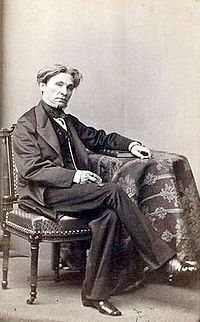Type a search term to find related articles by LIMS subject matter experts gathered from the most trusted and dynamic collaboration tools in the laboratory informatics industry.
Fyodor Bruni | |
|---|---|
 Photograph (c.1865) by Andrey Denyer | |
| Born | Fidelio Bruni 10 June 1799 |
| Died | 30 August 1875 (aged 76) |
| Resting place | Tikhvin Cemetery, Saint Petersburg |
| Education | Member Academy of Arts (1834) Professor by rank (1836) |
| Alma mater | Imperial Academy of Arts |
| Notable work | The Brazen Serpent, 1833–1841 |
| Spouse |
Angelica Serni (m. 1835) |
| Patron(s) | Alexei Yegorov, Andrey Ivanov, Vasily Shebuyev |
Fyodor (Fidelio) Antonovich Bruni (Russian: Фёдор Антонович Бруни; 10 June 1799 – 30 August 1875) was a Russian artist of Swiss Italian descent who worked in the Academic style.
His father, Antonio, was a Swiss Italian painter and art restorer who relocated to Russia in 1800 to work on a project at Saint Michael's Castle for Tsar Paul I.[1] At the age of ten, he was enrolled at the Imperial Academy of Arts, where he studied with Alexei Yegorov, Andrey Ivanovich Ivanov and Vasily Shebuyev.[2] He graduated in 1818 with the title "Artist Class XIV".[1]

His father, believing that a Russian art education was insufficient, sent him for further studies in Italy. At the age of twenty-two, he created his first large-scale work ("The Death of Camilla"), which was exhibited in the Capitol.[1] Ten years later, when the painting was shown in Saint Petersburg for the first time, it earned him the title of Academician. In the early 1830s, he began a monumental painting of "Moses Exalting the Brazen Serpent", but before its completion he was recalled to Saint Petersburg to work on a project at Saint Isaac's Cathedral and teach at the Academy.[1] He arrived in 1836 and produced several works for the Kazan Cathedral as well. Mikhail Botkin and Arseny Meshchersky were among his first students at the Academy.
In 1838, he was able to return to Rome to finish his work on Moses and the Serpent.[2] Two years later, it was completed and moved to Saint Petersburg where it was exhibited in one of the halls of the newly restored Winter Palace. It is now the largest canvas on display at the Russian Museum.[3] Returning to Rome for a third time from 1841 to 1845, he produced twenty-five sketches that would be the basis for frescoes at Saint Isaac's Cathedral. Some of the frescoes were executed by Bruni himself, others by various artists under his direction. The work was completed in 1853 and the originals are now stored at the Russian Museum.[4]
In 1849, he became the custodian of the gallery at the Hermitage Museum and was sent abroad twice to acquire paintings for the collection there. Six years later, he became Rector of the Department of Sculpture and Painting at the Academy.[4]
As he grew older, however, he became reclusive; even distancing himself from his own students and disappearing for weeks at a time. In his efforts to sustain the academic tradition, he began to openly express his dislike for younger artists and was forced to resign in 1871 because of his behavior.[4] By the time of his death, he was an honorary Professor at the Florence Academy of Fine Arts and the Accademia di San Luca in Rome.[2]

![]() Media related to Fyodor Bruni at Wikimedia Commons
Media related to Fyodor Bruni at Wikimedia Commons